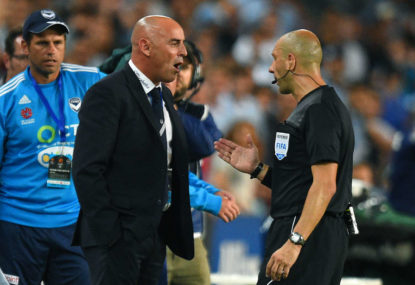As the Video Assistant Referee review system was introduced into the A-League this round, it was wondered exactly what difference having these square-eyed cave-dwellers on hand would make.
The irony of naming the hub for what is supposed to be a grand step into a technological future after a cave, how long would we have to wait to see the just fruits of this support net?
The A-League – perhaps more than most other competitions… actually, scratch that ‘perhaps’ – is in need of anything designed to enhance the level of officiating, and this was it, right here, in the cave.
And it only took one half of one game of play for the shouts calling for the new technology to be utilised to come pouring out.
Bruno Fornaroli and Iacopo La Rocca were engaged in a tussle, one of many that would pepper the evening. La Rocca went down in a heap, and as he rose he found Fornaroli churlishly wagging a finger in his face. La Rocca returned the finger-wag, as well as jutting his forehead – just a little – into the face of Fornaroli, adding emphasis and a little spice to his point.
This – considering the manner in which A-League refs have handed out red cards this season, as well as the man whose face he was invading – was highly unwise.
The contact, as is so often the case when Fornaroli ends up sprawled and gurning, was minimal, but the situation was beckoning for an eager flash of crimson.
Kris Griffiths-Jones did not unsheathe his red card, just his yellow one, booking the Adelaide defender.
Griffiths-Jones was, apparently, in communication with the VAR, who rightly had no issue with how the field official handled the incident.
It’s worth reiterating that the VAR can only intervene in what’s called match-changing situations; goals, the awarding or denial of a penalty, straight red cards, and cases of mistaken identity.
La Rocca later risked a second yellow card, and again found Griffiths-Jones in an incredibly forgiving mood, with Fornaroli again La Rocca’s ‘victim’, again rolling around on the floor, apparently stricken with some deathly pain deep in the gut, which he quickly ran off.
In that second incident, the VAR could not have intervened even if they’d wanted to, as a second yellow falls outside their purview. La Rocca wasn’t given a second booking, regardless.
But it’s the first incident where the video assistant may have had an effect, if only indirectly. The field official was fully aware that any rash awarding of a red card could be reviewed by his assistant, a peer with access to better angles, in slow-motion and perfect Ultra-HD clarity.
A decision assessing what is or isn’t a dismissable act of violence is basically a matter of interpretation, an area the VAR is keen to steer clear of. If Griffiths-Jones had sent off La Rocca, only for his ear-assistant to find, with the benefit of a perfect angle, that the contact in question was grossly embellished then he might have advised the referee to reverse his decision.
Essentially, simply the presence of an after-the-fact arbiter may have cooled Griffiths-Jones’ reaction to the sight of Fornaroli on the floor yet again clutching at his head.

Certainly, the fact that Griffith-Jones’ decision was backed up by his assistant not deciding to review it only reinforced the field official’s conservative reaction to Fornaroli’s inflamed play-acting. Had the Melbourne City striker really been hurt, butted with a Liverpool kiss, and Griffiths-Jones had acted too lenient, the VAR would have righted the situation. The referee could even have reviewed the footage on the sideline, if he had felt compelled.
Action replays have been available to the television football viewer for some time now. This super-charges every replayed moment. Tarek Elrich, who had to be stretchered off in this match, was the victim of a trauma repeated in slow motion, from every angle, landing sickeningly as he did, knee warping horridly, each repeated viewing prompting a fierce wince.
We knew from the stretcher and the enforced substitution that his ACL was likely damaged, we didn’t need half a dozen video flashbacks of it.
Similarly, all of Fornaroli’s antics – and every other thespian in the league – are heightened, given an air of the pantomime villain when we see them slowed down, their duplicity fully exposed. Now, it seems, the referee will have this view as well, albeit via a colleague and an earpiece.
There have been 23 red cards shown in the league, and every A-League fan reading this can probably think of at least one that didn’t need to appear.
Referees, ensconced in the world’s most fluid sport – well, water polo’s quite fluid, actually – as well as 22 players all perfectly happy to lie to his face, and thousands of partisan fans, have a difficult job to do.
They can be forgiven, sometimes, when they act too impulsively, or rush to a conclusion, or, even, want a share of the spotlight. But it would be better if they didn’t, and so any measure that can be put in place to help them keep their composure is a good thing.
Fornaroli egregiously dove twice in this game – even three times, as there was a late moment between he and La Rocca too – and his only reward was a single booking for an opponent. It must be said that Fornaroli was also fouled a great number of times genuinely; the Uruguayan is a most elusive, canny player.
The VAR does not dilute the referee’s authority; on the contrary, it enhances it, with the man in the middle now more an asset-laden android than a beleaguered bystander. And, like an android, the technology might also becalm him, make him feel more secure, less twitchy, less suspicious.
If rulings can be made swiftly, and indirect benefits like this persist, I cannot see the downside of a VAR-assisted A-League.






























































































